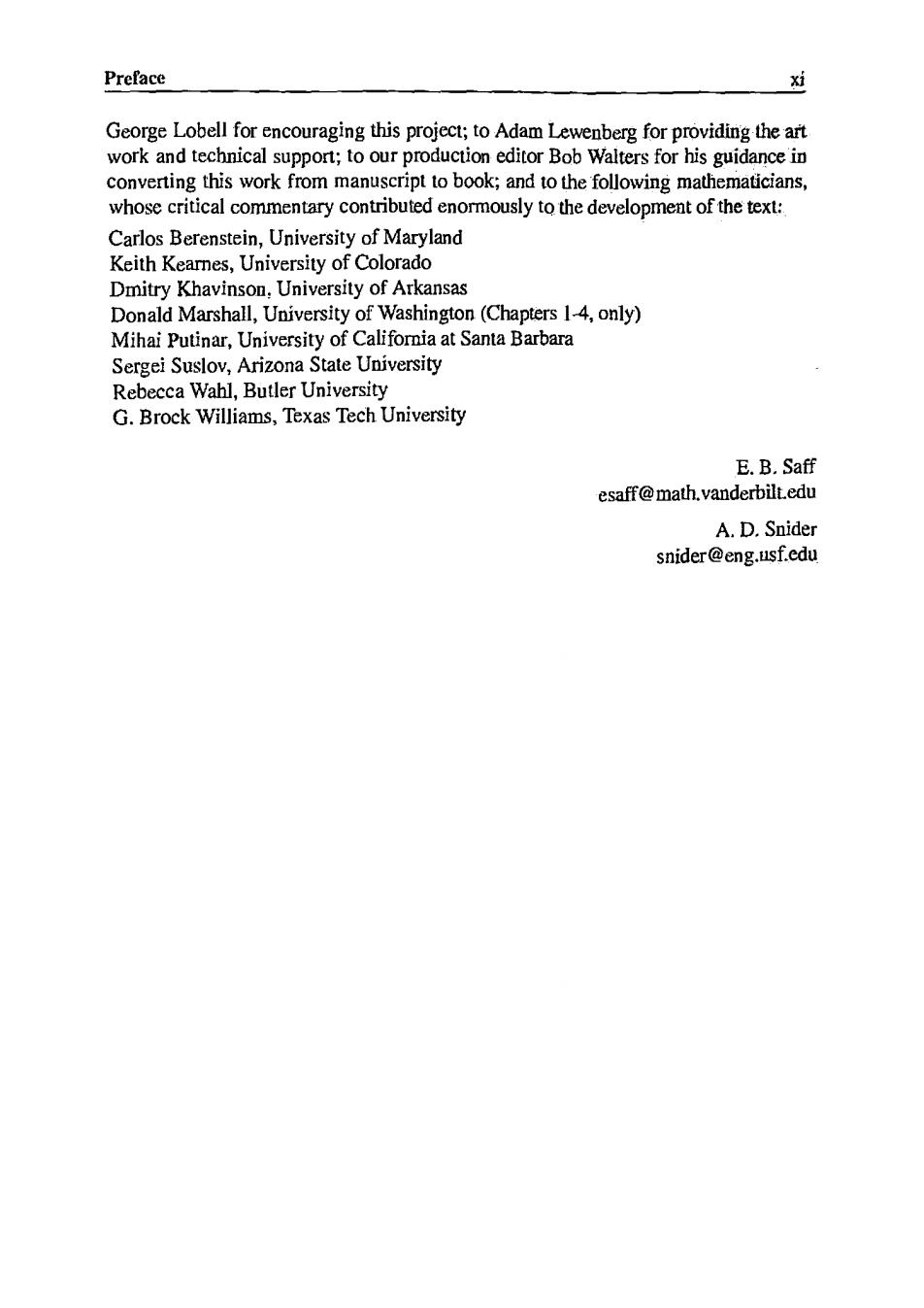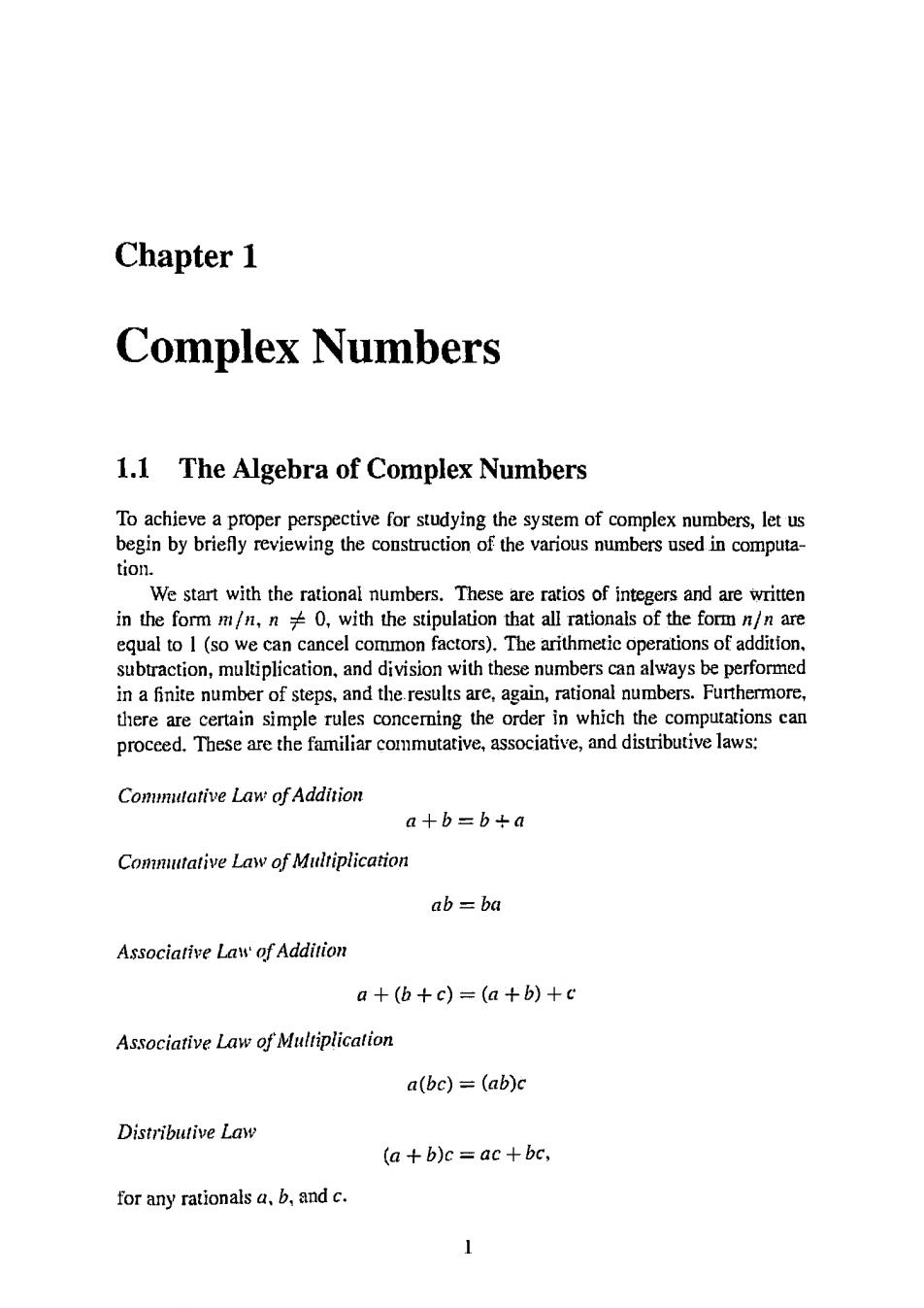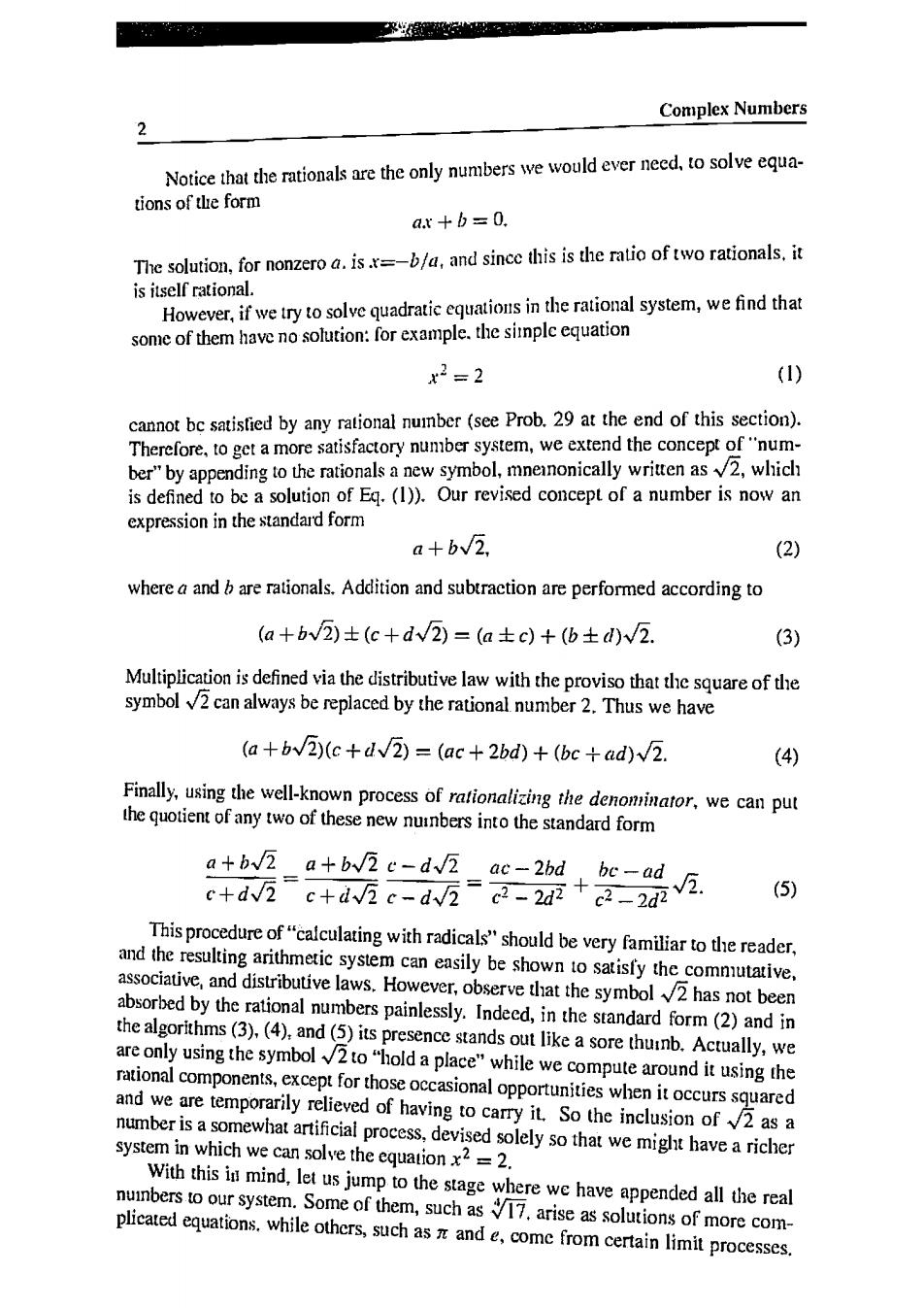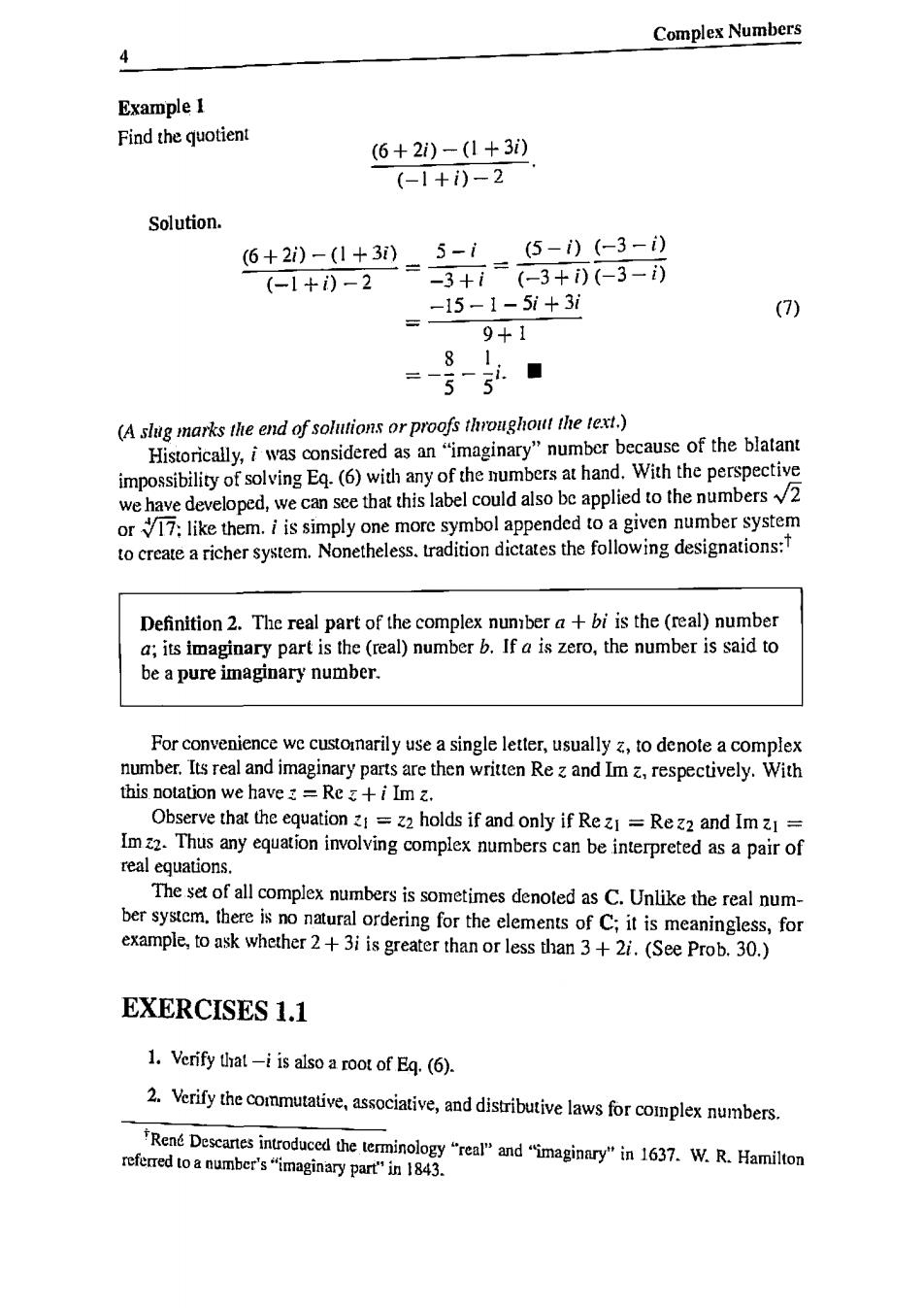
Preface xi George Lobell for encouraging this project;to Adam Lewenberg for providing the art work and technical support;to our production editor Bob Walters for his guidance in converting this work from manuscript to book;and to the following mathematicians. Carlos Berenstein,University of Maryland Keith Kearnes,University of Colorado Dmitry Khavinson,University of Arkansas Donald Marshall,University of Washington(Chapters 1-4,only) Mihai Putinar,University of Califoria at Santa Barbara Sergei Suslov,Arizona State University Rebecca Wahl,Butler University G.Brock Williams,Texas Tech University E.B.Saff esaff@math.vanderbilt.edu A.D.Snider snider@eng.usf.cdu

Chapter 1 Complex Numbers 1.1 The Algebra of Complex Numbers To achieve a proper perspective for studying the system of complex numbers,let us begin by briefly reviewing the construction of the various numbers used in computa- tion. We start with the rational numbers.These are ratios of integ s and are written in the form m/n,n0,with the stipulation that all rationals of the form n/n are equal to I (so we can cancel common factors).The arithmetic operations of addition. subtraction,multiplication,and division with these numbers can always be performed in a finite number of steps.and the results are,again,rational numbers.Furthermore. there are certain simple rules concering the order in which computations can proceed.These are the familiar commutative,associative,and distributive laws: Comutative Law of Addition a+b=b+a ab=ba Associative Law of Addition a+(b+c)=(a+b)+c Associative Law of Multiplication a(bc)=(ab)c Distributive Law (a+b)c=ac+bc, for any rationals a,b,and c

Complex Numbers 2 Notice that the rationals are the only numbers we would ever need,to solve equa- tions of the form a.x+b=0. The solution,for nonzero a.isb/a,and sincc this is the ratio of two rationals.it is itself rational. However,if we try to solve quadratic quations in the rational system,we find that some of them have no solution:for example.the simple equation x2=2 (1) cannot be satisfied by any rational nuinber(see Prob.29 at the end of this section). Thereoreogetamore isfctory umsystemwed thecpm ber"by appending to is ofE(.Our revised a number is now an expression in the standard form a+bV2 (2) where a and b are rationals.Addition and subtraction are performed according to (a+bv2)±(c+dW2)=(a±c)+(b±d)√2. (3) Multiplication is defined via the distributive law with the proviso that the square of the symbolcan always be replaced by the rational number 2.Thus we have (a+bv2)(c+d2)=(ac+2bd)+(bc +ad)v2. (4) Finally,using the well-known process of rationalizing the denominator.we can put thefywof hesewintthstadard form atbv2 atbic-d +9+8二-警器+会器a (5) This procedure ofcaculating with radicals"should be very familiar to the reader and thebeshwisythe comve. assoivndisbutive laws.However.thesymbol √2 has not been absorbed by the rational numbers painlessly.Indeed,in the standard form(2)and in the algorithms(3),(4),and(5)its presencest tands out like a sore thumnb.Actually,we arny using th symbolpace"while we comuteonh rational components,except for thos and we are ter se occasional opportunities orarily re s when it occurs squared number is a s eved of having to camry it So the inclusion ofsa system in omewhat artificial process.devised solely so that we might have a richer hich we can solve the equationx2=2. With this in mind,let us jump to the stage where we have a nuinbers to our system.So ppended all the real me of them,such as17.arise as solutions of more com- plicated equations.while others,such asande,come from certain limit processes

1.1 The Algebra of Complex Numbers 3 Each irrational is absorbed in a somewhat artificial ma nner,but e again the re adahnaeopeaagaaeenthe At this point we observe that we still cannot solve the equation x2=-1. (6) But now our experience suggests that we can expand our number system once again appending a symbol for a soon to E.(6)instead of it is symbol (Engine often use the le j.)Next we im ate the model of expressions (2)thr (5)(prtanngoan therbyeraliourof number as follows: Definition 1.A complex umber is an expression of he formb.wher and b are real numbers.T vo comp +bi and c+di are said to be equal (a+bi =c+di)if and only if a=c and b=d. The operations of addition and subtraction of complex numbers are given by (a+bi)±(c+di)=(a士c)+(b±d)i, where the symbol :=means"is defined to be." Inaccordance with the distributiv w and the proviso that we postul The multiplication of two complex numbers is defined by (a +bi)(c+di):=(ac-bd)+(bc+ad)i To compute the quotient of two complex numbers,we again"rationalize the de- nominator' a+bi a+bi c-di ac+bd bc-ad e+di-c+dic-dǖ=c+a+ c2+d7 i Thus we formally postulate the following: The division of complex numbers is given by a+bi (fc2+d2≠0), These arerus for compuing in thecompenumber system.The usual alge- braic properties(commutativity,associativity,etc.)are easy to verify and appear as exercises. The algebraic aspects of feldare discussed in Ref.5a this full accep tance as genuine mathematical objects

Complex Numbers Example I Find the quotient (6+2i)-(1+3i) (-1+i)-2 Solution. 6+2)-0+30= 5-i (5-i)(-3-i) (-1+i)-2 3+=-3+)-3-i =-15-1-5+3 7 9+1 81 (A slug marks the end of solutions or proofs throughout the text.) Historically,i was considered as an"imaginary"number because of the blatant impofnE()withay ofmhd. With the perspective we ha e develo ped,we can see that this label could also be applied to the numbers2 or 17:like them. to create a richer system.Nonetheless.tradition dictates the following designations: Definition 2.The real part of the complex number a+bi is the (real)number a;its imagina be a pure imaginary number For convenience we customnarily use a single letter,usually z,to denote a complex number.Its real and imaginary parts are then writen Rez and Im,respectively.With this notation we have=Re+i Im. Observe that the equation=z holds if and only if Re=Rez2 and Im= Im.Thus any equation involving complex numbers can be interpreted as a pair of real equations. The set of all complex numbers is sometimes denoted as C.Unlike the real num- ber systcm.there is no natural ordering for the elements of C;it is meaningless,for example,to ask whether 2+3i is greater than or less than 3+2i.(See Prob.30.) EXERCISES 1.1 1.Verify that-i is also a root of Eq.(6). 2.Verify thecommutative,associative,and distributive laws for complex numbers. Ren Descartes introduced thet efedtoumber's"maginary andmin 167.W.Hamiton